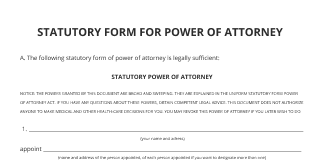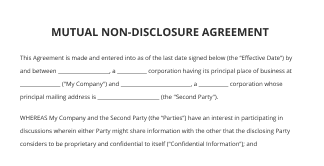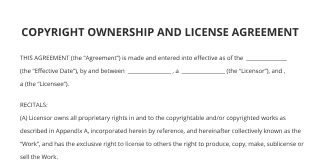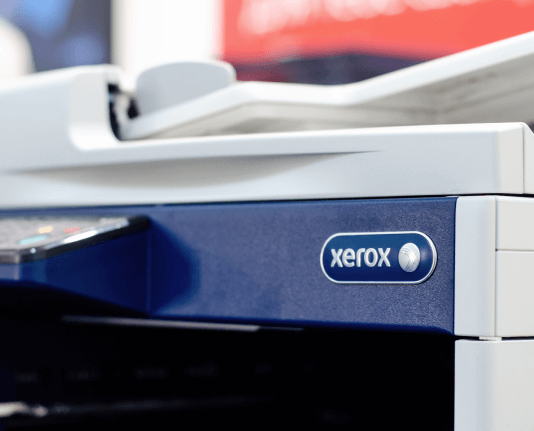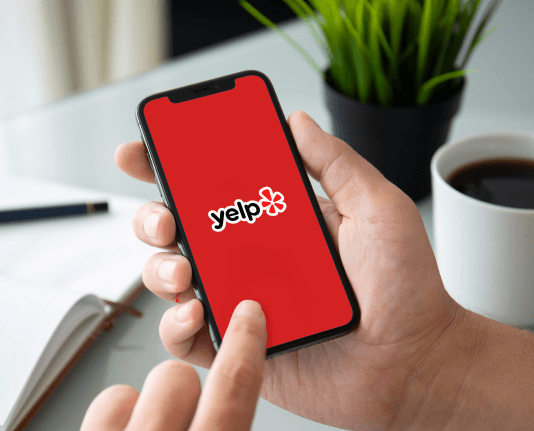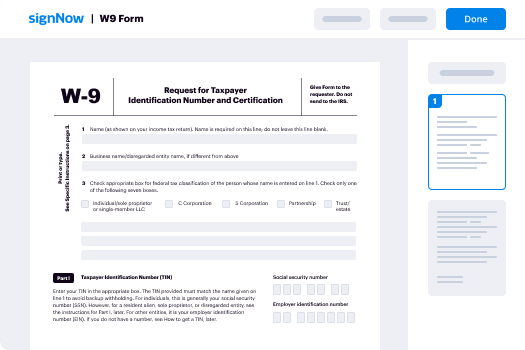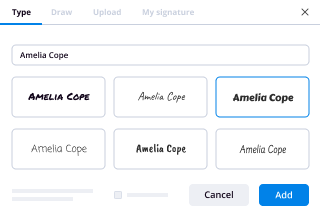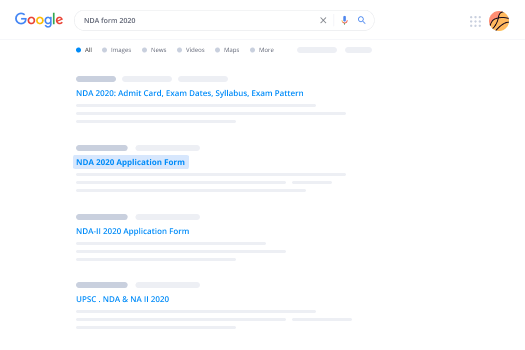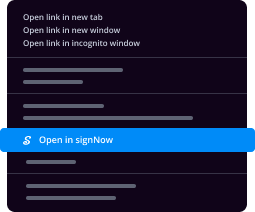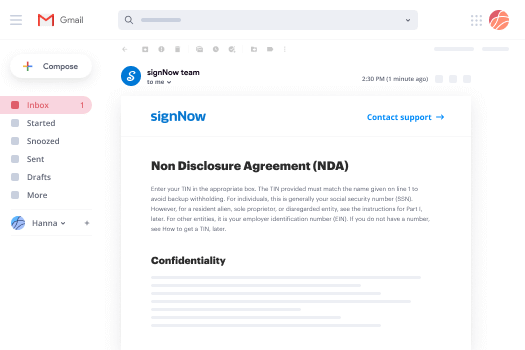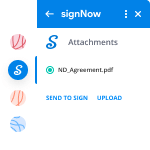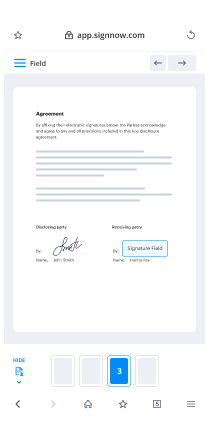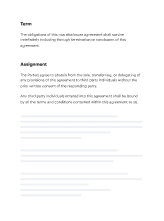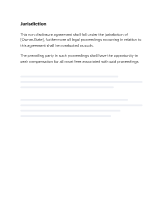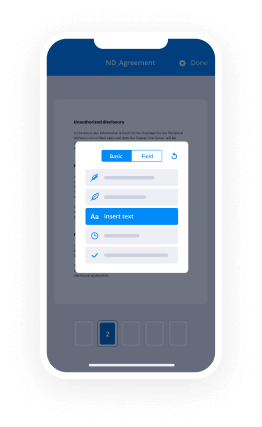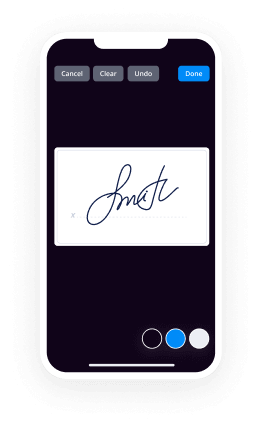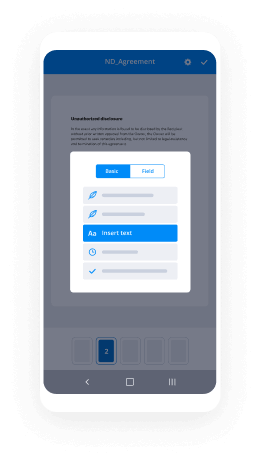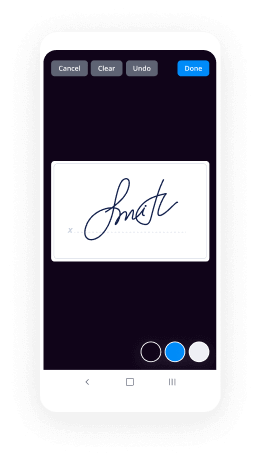Signatory Business Requirements Document Template (BRD) Made Easy
Improve your document workflow with airSlate SignNow
Flexible eSignature workflows
Fast visibility into document status
Easy and fast integration set up
Business requirements document template excel on any device
Comprehensive Audit Trail
Rigorous security requirements
See airSlate SignNow eSignatures in action
airSlate SignNow solutions for better efficiency
Our user reviews speak for themselves






Why choose airSlate SignNow
-
Free 7-day trial. Choose the plan you need and try it risk-free.
-
Honest pricing for full-featured plans. airSlate SignNow offers subscription plans with no overages or hidden fees at renewal.
-
Enterprise-grade security. airSlate SignNow helps you comply with global security standards.

Your step-by-step guide — sample business requirements document
Using airSlate SignNow’s electronic signature any company can accelerate signature workflows and eSign in real-time, supplying an improved experience to customers and staff members. Use signatory Business Requirements Document Template (BRD) in a couple of simple actions. Our mobile-first apps make working on the run feasible, even while offline! Sign contracts from any place in the world and complete deals in no time.
How to fill out and sign a sample business requirements documents
- Log on to your airSlate SignNow profile.
- Locate your record within your folders or upload a new one.
- Open up the record and make edits using the Tools menu.
- Drop fillable boxes, type text and eSign it.
- Add numerous signers using their emails and set the signing order.
- Indicate which individuals will get an executed version.
- Use Advanced Options to restrict access to the document and set an expiry date.
- Tap Save and Close when completed.
Furthermore, there are more advanced capabilities open for signatory Business Requirements Document Template (BRD). List users to your collaborative work enviroment, view teams, and track teamwork. Millions of consumers all over the US and Europe agree that a solution that brings people together in a single unified work area, is what organizations need to keep workflows working effortlessly. The airSlate SignNow REST API enables you to embed eSignatures into your app, website, CRM or cloud. Check out airSlate SignNow and get faster, smoother and overall more effective eSignature workflows!
How it works
airSlate SignNow features that users love
See exceptional results sample brd document template
Get legally-binding signatures now!
FAQs sample brd template
-
How do I create a BRD document?
To create a BRD document using airSlate SignNow, simply follow these steps: 1. Begin by logging into your airSlate SignNow account and navigating to the Documents section. Click on the "Create Document" button and select the option to create a new document from scratch. 2. Use the intuitive drag-and-drop interface to upload the necessary files and arrange them in the desired order. You can easily add text fields, checkboxes, and signature blocks to the document using the provided tools. 3. Once the document is set up, you can customize the workflow to fit your specific needs. Use airSlate SignNow's high-volume eSignature features to easily send the document to multiple recipients for signing. Track the progress of each signature and send reminders to ensure timely completion. 4. With airSlate SignNow's robust document management capabilities, you can streamline your workflows and increase productivity. Set up templates for commonly used documents, automate repetitive tasks, and integrate airSlate SignNow with your existing business systems for seamless document management. By using airSlate SignNow, you can impress your customers with a professional and efficient document signing process. Ensure a smooth customer experience by providing a secure and user-friendly platform for them to sign documents electronically. Not only will airSlate SignNow save you time and increase productivity, but it will also help you save money. Eliminate the need for printing, scanning, and shipping documents by going paperless with airSlate SignNow. Plus, airSlate SignNow offers flexible pricing options to fit the needs of small and medium businesses, maximizing your return on investment. With airSlate SignNow, you can confidently create BRD documents with customizable eSignature workflows. Join thousands of satisfied business owners, managers, and employees who trust airSlate SignNow for their document signing needs. Try airSlate SignNow today and experience the power of electronic signatures. -
What is the difference between a BRD and FRD?
The main difference between a Business Requirements Document (BRD) and a Functional Requirements Document (FRD) lies in their focus and scope. A BRD outlines the overall business objectives, goals, and requirements, while an FRD delves deeper into the specific functionalities and features that a system or software should possess to fulfill those requirements. Think of the BRD as the big picture and the FRD as the detailed blueprint. With airSlate SignNow, small and medium-sized businesses can increase productivity with streamlined document workflows, impress customers with efficient eSign processes, and save money by eliminating the need for physical documents and manual signing. Our high-volume eSignature features empower users to maximize their ROI by automating repetitive tasks and ensuring compliance with secure and legally-binding electronic signatures. Trust airSlate SignNow to provide you with a customizable eSignature solution that will help you move fast with everything you need to send, sign, and manage your important documents. -
What is BRD and FSD?
BRD stands for Business Requirements Document and FSD stands for Functional Specification Document. These are key documents used in software development projects to define the business requirements and functional specifications, respectively. The BRD outlines the goals and objectives of the project, while the FSD provides detailed information about how the system will function to meet those goals. By clearly documenting and communicating these requirements and specifications, airSlate SignNow helps businesses ensure that their software development projects are successful and meet their needs efficiently. With airSlate SignNow, businesses can increase their productivity by streamlining their document workflows, impress their customers with a seamless eSignature experience, and save money while maximizing their ROI with customizable eSignature workflows. -
What is a business requirement document sample?
A business requirement document sample is a template that outlines the specific requirements and expectations for a business project or initiative. It helps to define the scope of the project, identify the key stakeholders, and outline the desired outcomes. A sample business requirement document typically includes sections for goals and objectives, functional requirements, technical specifications, and project timelines. airSlate SignNow is an electronic signature solution that is designed to help small and medium-sized businesses streamline their document workflows. With airSlate SignNow's high-volume eSignature features, users can increase productivity by quickly and easily sending and eSigning documents. In addition, airSlate SignNow allows businesses to impress their customers with a seamless and professional signing experience, ultimately helping to build stronger relationships. By using airSlate SignNow, businesses can also save money by reducing the need for paper documents and eliminating the costs associated with printing, scanning, and mailing. By maximizing their ROI with airSlate SignNow, businesses can confidently move forward and achieve success in their document processes. -
What is included in a requirements document?
A requirements document is an essential part of any project, as it outlines exactly what needs to be accomplished. It includes a detailed description of the desired features and functionalities, as well as any constraints or limitations. Additionally, it may contain information on the project's timeline, budget, and resources required. airSlate SignNow is a best-in-class electronic signature solution that empowers businesses to streamline their document workflows and enhance productivity. With airSlate SignNow, users can easily send and eSign documents, eliminating the need for manual processes and paperwork. This not only saves time, but also impresses customers with a seamless and professional experience. By implementing airSlate SignNow, businesses can also save money while maximizing their return on investment. The high-volume eSignature features offered by airSlate SignNow enable users to process a large number of documents efficiently, reducing administrative costs and increasing overall productivity. With airSlate SignNow, SMBs and mid-market companies can confidently embrace digital transformation and propel their success. -
What is business required document?
A business required document is a crucial piece of paperwork that is necessary for the proper functioning and operation of any company. These documents often include contracts, agreements, invoices, and other legal papers that are essential for conducting business transactions. With airSlate SignNow, an advanced electronic signature solution, businesses can seamlessly streamline their document workflows and increase productivity. By utilizing airSlate SignNow's high-volume eSignature features, users can impress customers, save money, and maximize their return on investment. With airSlate SignNow, SMBs and mid-market businesses can confidently move fast and efficiently with their document management processes, ultimately showcasing their expertise and professionalism. -
What information is included in the business requirements document?
The business requirements document (BRD) is a comprehensive document that outlines the specific needs and objectives of a company for a particular project or initiative. It typically includes information such as the project scope, objectives, functional requirements, technical specifications, user requirements, and any constraints or dependencies. The BRD serves as a guide for all stakeholders involved in the project, ensuring that everyone is on the same page and working towards a common goal. By including all the necessary information in the BRD, companies can effectively communicate their needs to external vendors or internal development teams, enabling seamless collaboration and successful project execution. -
What does a BRD consist of?
A BRD, or Business Requirements Document, consists of several key components. It typically includes an executive summary, which provides a high-level overview of the project and its goals. It also includes a detailed description of the business requirements, outlining what the system or solution should do and how it should perform. Additionally, a BRD includes functional and non-functional requirements, system constraints, and any relevant assumptions or dependencies. Overall, a BRD serves as a blueprint for the project, ensuring that all stakeholders have a clear understanding of the desired outcome. airSlate SignNow is an advanced electronic signature solution that empowers businesses to streamline their document workflows. With its high-volume eSignature features, users can increase productivity by automating the signing process for large volumes of documents. The customizable workflows and intuitive interface impress customers with smooth and efficient transactions. By eliminating the need for printing, faxing, and shipping physical documents, airSlate SignNow helps businesses save money while maximizing their return on investment. For small and medium-sized businesses, managers, and employees accountable for documents, airSlate SignNow offers a unique opportunity to revolutionize how agreements are handled. With airSlate SignNow, you can easily create, send, and sign documents with just a few clicks. Its user-friendly interface and customizable features allow you to tailor the eSignature experience to your specific business needs. This efficient and reliable solution not only saves time but also ensures the security and legality of your documents. With airSlate SignNow, you can confidently move fast and stay ahead of the competition.
What active users are saying — sample business requirements document
Related searches to market requirements document pdf
Signatory business requirements document template brd
friends in this lecture we will learn about the RDR business requirement documentation information technology projects are initiated to meet business requirements the information technology projects succeed them they deliver the intended business requirements they fail then they fail to do so it looks easy to define business requirements and then choose among them to be delivered for information technology implementations but in reality it needs the master to understand business requirements document them properly and also gained acceptance with the stakeholders that these requirements are the ones to be addressed in the information technology project at hand got no wonder business requirements documentation is an inseparable part of an information technology project it is also a favourite topic of discussion of interviewers interviewing for information technology business analysts and managerial positions let us now move on to the agenda of this session on business requirement documentation friends allow me now to take up the agenda of this session at the start we will first have a brief introduction and we'll also set the context of this lecture then we will name various requirement documents which are prepared on an IT project we will introduce to you the readers or consumers of these requirement documents good practice of documenting requirements will be discussed next these good practices are also to be kept in mind when we prepare a business requirements document with all this understanding and clarity we will now take up the following what is a business requirement document or BRD what are business requirements why do business requirements change what are the objectives the BRT who utilizes the BRT good BRT practices and finally we will take up structure for a be Hardy document while we discuss the structure of a business requirements document we will also discuss what not to write in a business requirements document finally this session will close with a summary let's now start with introduction a business requirement document is normally prepared by the client or its representative before RFP or request for proposal for IT project is prepared the BR D talks about the new requirements of the business to be fulfilled to me the company goals the objectives mission and vision in the coming sections of this session we will also learn why business requirements change with time in this session when we talk about the RTO business requirement document it is to be underlined that it is being discussed with respect to IRT projects being developed and implemented to meet the identified business requirements before we dive into the depths of a business requirement document let us get acquainted with various requirement documents which are prepared for an IT project some key requirement documents associated with IT projects are vision document business requirement document scope document feasibility study document software functional requirement document as if to be study document user requirements analysis document and software requirement specification document in addition to these requirement documents when an IT project is completed various reference documents are also prepared they are minutes of meeting and agenda questionnaires and responses interview notes and presentations out here in this session we will not get into details of all the key requirement documents and reference documents we will do it in other video sessions now let's understand who reads these documents readers of requirement documents our project sponsor and users project development team test management team implementation team business analyst himself subject matter experts and other stakeholders as the case may be to get into details of these stakeholder roles you can go through our video session on stakeholder analysis I am sure by now you want to take me to details of a business requirement document but before we do that let us learn good practices for requirement documentation the purpose to discuss this here is the fact that these good practices apply to documenting business requirement documents as well friends the first good practice is to define the standard document structure for your requirement document the document structure for various requirement documents may vary from one company to another however for a particular organization the document structure of particular requirement document should be standardized it means we follow the same structure of a requirement document on a company-wide basis this results into an easy reading for the readers they know what content to expect and where in a requirement document that also becomes easy for the reviewers of the document to do quality check sand off course you can't tailor it to suit particular requirements of your own enterprise now we will move on to next good practice which is explaining how this requirement document can be utilized second good practice to prepare requirement documents is to have a section within the requirement document where we explain how to use the document here you should explain different category of readers this requirement document is aimed at different sections of embarrased for a particular audience should also be explained say for example in a stakeholder requirements documents various stakeholder types have interest in their own set of requirements so they would like to jump to the relevant area within the document document dependencies which means if particular sections of requirement document has references to some other documents then those pointers must also be provided if to understand the requirement document for a section of it you need a particular technical background from the reader you must explain the same as well now it is time to move on to requirement document good practice 3 requirement document good practice theory is to define specialized terms this means you have to prepare glossary for your requirement document in fact glossary of words is an integral constituent of a requirement document it checks multiple interpretations of commonly used term for words by stakeholders I generally keep glossary at the start of the requirement document it then generates attention even from the most busy executives I will share my tip for preparing glossary Zinn a quick and an effective manner across several projects I prepared a common glossary for the domain and then utilize relevant terms after making suitable amendments for the project in question requirement documentation good practice for is to adapt standard notations for example BPM Ben and UML notations wherever needed you should not rely only on your natural language abilities to write a requirement document you can use UML and utilize specialized requirements software's to prepare your requirement documents with all this knowledge about various requirement documents now it is time learn about business requirements and the business requirements document or BR D let us now understand what our business requirements and why do they change business requirements are the critical activities of an enterprise that must be performed to meet the organizational objectives while remaining solution independent the following are the examples of business requirements example one an insurance company wants to provide 24 by 7 loss intimation facility to the insured's because competition has done the same example to the pharma company wishes to impart timely new product knowledge to its medical representatives example 3 an IT company wants to increase its assessment effectiveness and assessment throughput to individuals applying for various jobs next we will dwell upon the changing nature of business requirements business requirements change because of several reasons they can change due to change in customer preferences change in competitor offerings change in regulation availability of new technology at an economically viable price change in company strategy and offerings the enterprise or the company has Timothy's changing business requirements in order to keep itself competitive and relevant in the marketplace the changing business requirements can be met by one or more of the following ways by organization restructuring new hiring etc by introducing new software solutions by developing new products and services so initiating new IT projects implementing new IT solutions is one of the many ways to meet changing business requirements however today RT has become an integral part of any change so even if we do organizational restructuring we may need an additional IT solution to be deployed as an aid to this restructuring what is a business requirement document of BR the addresses business requirements of the project and does not recommend solutions who prepares the be Hardy normally a business analyst for a consultant on client roles prepares the be Hardy went client and software vendor work in close collaboration the IT business analyst of the software vendor can also prepare the BRT the objective of a business requirement document let us now learn what are our objectives when we prepared a BRT the BRT is prepared to gain agreement with stakeholders about business requirements it provides a guidance to technology service provider about business requirements for desiring the technical solution the BRT also describes the needs of business and customers to be met after implementation of this project the BRT template before I take you to my recommended be Hardy template there is a caveat there is no single standard Bihar deed format which is followed everywhere there is no single method to arrive at business requirements and to prioritize them when you prepare a business requirements document you can follow the following template or documents structure contents of a be Hardy template cover page version control and approvals index glossary business requirements summarized project scope stakeholder analysis detailed business requirements summary and references what a business requirement document does not include is a following software solution requirements budgets costs timelines etc functionality or functional requirements of the software UML BPM and diagrams etc software specifications hardware specifications short but a packed session you have learned a lot about a business requirements document friends allow me now to summarize this session the be Hardy captures the requirements of the business which should be fulfilled to me the company goals the objectives mission and vision the BRT is referenced by all the stakeholders of the IT project the be Hardy allows you to align functional and non-functional requirements of the software with business goals the objectives and requirements qbi institute conducts like a business analyst training programs agile certification programs and Six Sigma programs you are welcome to call this now a warm thank you for a leading this session
Show more




